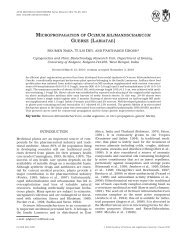ACTA BIOLOGICA CRACOVIENSIA
ACTA BIOLOGICA CRACOVIENSIA
ACTA BIOLOGICA CRACOVIENSIA
Create successful ePaper yourself
Turn your PDF publications into a flip-book with our unique Google optimized e-Paper software.
MODEL SYSTEMS, COMPUTATIONAL AND IN SILICO STUDIES OF CAROTENOIDS<br />
[DOPC], sphingomyelin [ESM], and cholesterol, mixed at a molar<br />
ratio of 1:1:1), and in models of photoreceptor outer-segment<br />
membranes (containing palmitoyl-docosahexaenoyl-PC [PDHAPC],<br />
distearoyl-PC [DSPC], and cholesterol mixed at a molar ratio of<br />
1:1:1), macular xanthophylls, lutein, and zeaxanthin are not distributed<br />
uniformly. They are substantially excluded from raft<br />
domains rich in saturated lipids and cholesterol and remain ~10<br />
times concentrated in bulk domains, which are enriched in unsaturated<br />
lipids (DOPC or PDHAPC) (Wisniewska and Subczynski,<br />
2006; 2006a). The selective accumulation of lutein and zeaxanthin<br />
in direct proximity of unsaturated lipids, which are especially<br />
susceptible to lipid peroxidation, should be very important as<br />
far as the antioxidant activity of these xanthophylls is concerned.<br />
Therefore, the protective role of lutein against lipid peroxidation<br />
was investigated in raft-forming mixtures and photoreceptor<br />
model membranes and compared with their antioxidant activity<br />
in homogenous membranes composed of unsaturated lipids.<br />
Lipid peroxidation was induced by photosensitized reaction using<br />
rose bengal and monitored by an MDA-TBARS test, iodometric<br />
assay, and oxygen consumption (using EPR spectroscopy oximetry<br />
and the mHCTPO spin label as an oxygen probe). The results<br />
show that lutein protects unsaturated lipids more effectively in<br />
raft-forming mixtures than in homogenous membranes. This suggests<br />
that the selective accumulation of macular xanthophylls in<br />
the most vulnerable regions of photoreceptor membranes may<br />
play an important role in enhancing their antioxidant properties<br />
and their ability to prevent age-related macular diseases (such as<br />
age-related macular degeneration [AMD]).<br />
Supported by grant EY015526 of the NIH.<br />
REFERENCES<br />
WISNIEWSKA A and SUBCZYNSKI WK. 2006. Accumulation of macular xanthophylls<br />
in unsaturated membrane domains. Free Radic. Biol.<br />
Med. 40: 1820-1826.<br />
WISNIEWSKA A and SUBCZYNSKI WK. 2006a. Distribution of macular xanthophylls<br />
between domains in a model of photoreceptor outer<br />
segment membranes. Free Radic. Biol. Med. 41: 257-1265.<br />
Vol. 53, suppl. 1, 2011<br />
ORAL PRESENTATIONS<br />
17–22 July 2011, Krakow, Poland<br />
Importance of stability tests of lycopene<br />
in experimental animal feed<br />
Kati Fröhlich1,2 , Volker Böhm1 , Mario Lorenz3 ,<br />
Mandy Fechner3 1Institute of Nutrition, Friedrich Schiller University Jena,<br />
Dornburger Str. 25-29, 07743 Jena, Germany,<br />
2Food GmbH Jena Analytik Consulting, Orlaweg 2, 07743 Jena,<br />
Germany,<br />
3Charité – Universitätsmedizin, Schumannstr. 20-21, 10117 Berlin,<br />
Germany,<br />
k.froehlich@food-jena.de, volker.boehm@uni-jena.de,<br />
mario.lorenz@charite.de, mandy.fechner@charite.de<br />
The EU-funded project "LYCOCARD" (www.lycocard.com) investigated<br />
the role of lycopene, tomatoes/tomato products in reducing<br />
the risk of cardiovascular diseases. An animal study with NZWrabbits<br />
(Charité Berlin, Germany) examined the influence of<br />
lycopene on atherogenesis induced by high-cholesterol diet.<br />
Lycopene is sensitive to degradation and isomerization.<br />
Therefore, an important part of the animal study was to investigate<br />
the lycopene stability in lycopene-enriched experimental feed<br />
according to diverse processing methods, formulations and storage<br />
conditions. These experiments were mandatory to ensure the<br />
correct daily dose of lycopene in animal diets. Therefore, storage<br />
stability of carotenoids should always be monitored in chow used<br />
for animal studies.<br />
Lycopene beadlets, provided by DSM Nutritional Products<br />
Ltd. (Basel, Switzerland), were used for production of different<br />
experimental diets (ssniff Spezialdiäten GmbH, Soest, Germany<br />
or Altromin Spezialfutter GmbH & Co. KG, Lage, Germany). To<br />
test the stability of lycopene in rabbit chow enriched with<br />
lycopene beadlets, lycopene content as well as the isomer pattern<br />
were measured in a variety of chows (different processing conditions:<br />
e.g. temperature, pressure, added oxygen absorber) over<br />
the course of time (8 days, 3 months) under various storage conditions<br />
(different temperatures, with and without exposure to<br />
light and oxygen) by using C30-HPLC (Fröhlich et al., 2007).<br />
In contrast to the high stability of unprocessed lycopene<br />
beadlets (6 months at room temperature – no significant change),<br />
strong decrease of lycopene contents in chows enriched with<br />
beadlets was observed. After 8 days of storage, the lycopene contents<br />
were reduced significantly by about half of the basal level.<br />
Exposure to light showed no significant effects on lycopene stability.<br />
During the long-term stability tests (3 months), reduction<br />
of lycopene was significant and depending on the storage temperature.<br />
Surprisingly, no significant changes in the isomer ratio (all-<br />
E:Z) of lycopene were observed during all storage experiments.<br />
Special thanks are given to the diploma students Anne Trautmann and<br />
Claudia Nebe (FSU Jena, Germany) for the carotenoid analysis and the<br />
EU (LYCOCARD, IP: 2006-016213) for financial support.<br />
REFERENCES<br />
FRÖHLICH K, CONRAD J, SCHMID A, BREITHAUPT DE, BÖHM V. 2007. Int J<br />
Vitam Nutr Res 77: 369-375.<br />
107












